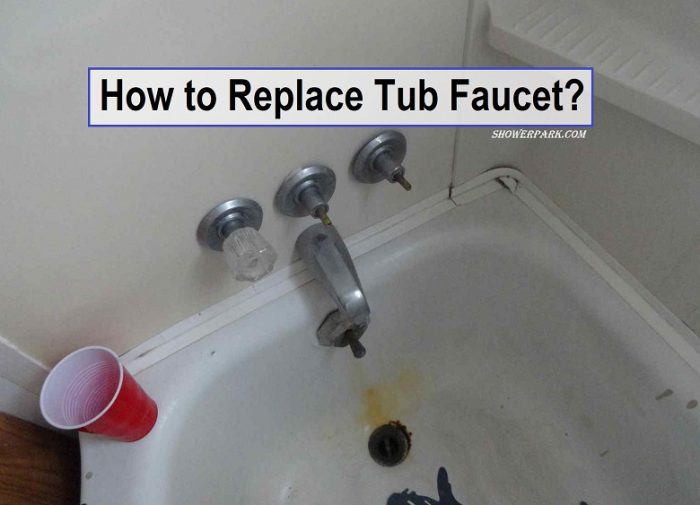Every now and then, tab faucets would require some upgrade. This could be due to breakages, blockages or even wearing out. Continuous use of the faucet may make it to lose the lining hence getting rust.
Apart from the normal wear and tear, the bathroom may call for general upgrade. Many things then do necessitate replacement of the tub faucet. With the advancement in technology, newer models of tubs are produced continuously.
Installing such makes your bathroom look good always. How then is the replacement of the tub done? For more information, read through this article.
What necessitates the faucet to be changed?
There are several reasons which can necessitate one to change the faucet. You can change the tub faucet when:
- It is broken either at the main tub or the handle.
- Changing the bathtub and the faucet which you have been using is not compatible with the new bathtub.
- The old faucet is worn out beyond repair. It can be due to rust or even exhausted valves.
- Giving the water system a general facelift or upgrade.
Many other reasons cause make one change the faucet. This, consequently, means that the above reasons are not explicit.
What are the materials required for this job?
It is important to assemble all the required tools for work. Some of the tools to use for this work are:
- The pliers.
- A new faucet for replacement.
- A saw.
- Pipe wrenches.
- Silicone caulk
- Screwdrivers.
How to replace bathtub faucet single handle?
Generally, the process of replacing a faucet, either single or double-handled is more or less the same. There is no much difference. The steps to follow are:
Switch off the water.
This is usually done from the main valve or even from the source of a single faucet. If you are connected to billable water, such as that from the municipality, then the main valve is usually next to the meter.
Alternatively, you can switch the water off from a dedicated valve. Water should be left turned off until the entire process has been completed.
There is some water that will remain in the faucet even after switching it off. You will need to open the faucet to drain off this excess water. Run the tub until the taps are fully dry. Then turn off the faucet again.
Take off the bathtub trim.
These are the entire components entire old tub faucet. They include the handle, plate and spout. This done by a screw driver or even the pliers. After removing the trim, ensure that you take off the spout as well.
All these components are quite delicate, hence you should handle them with more care. Some are prone to breakages when mishandled. Others such as the faucet can suffer from scratches. Be gentle on these fittings.
If your tub has an access panel, you will need to take it off as well. This could be located on the other side of the wall or on any part of the pipe.
Cut off the pipes.
Pipes connected to the old bathtub faucet has to be cut off. This can be done by the use of a pipe cutter. Do not cut near the valves, because you may end up damaging them.
To remove the valves from the old pipe, just unscrew the nuts using a pipe wrench. As usual, be careful not to damage the old system. Handle it with care.
You are reminded that a pipe cutter will work well on the pipes if the pipe is glued or even soldered.
Make any necessary changes to the handle and the faucet.
This is the final stages of taking off the old system. In readiness for the installation of a new tub faucet, correct adjustments have to be done. Such adjustments includes thing such as connecting the single handle faucet to both hot and cold water connections. Since it is a single handle one, the faucet has to perform all the functions similar to what a double handle faucet does.
Adjustments to the tub spout and the shower line has to be done as well before reconnecting it to the new faucet. You will need to fix and secure the valve to the main framing. If necessary, install a new valve support system. From there, connect both the cold and the hot water lines by use of a pipe wrench.
Attach the spout.
Put the new spout in place of the old one. The new one comes together as a package when you bought the new system. Fasten the new spout by use of a screw driver. Do not over tighten the screws since you may need to remove them some time in future. This saves you from breakages and destruction.
Install the new faucet.
The new faucet trim is to be installed at this point. This includes things such as the handle, the plate and any other adjoining accessory. Screw the handle in to its new place and cover the holes with new materials. Attach the plate together with the handle over the single valve. Ensure that they perfectly fit each other.
Seal off the system.
With a silicone caulk, seal off all the connections between the items of the trim. There are several joints in the system which needs to be enforced against leakages by caulking it.
Test the system.
To be sure that you did a good job, you have to run water in the system. Confirm whether the new system is leaking water and make necessary adjustments. Check as to whether the new single handle can discharge both hot and cold water. Where the system has some problems, then it is high time to do the adjustments. If you have everything as expected however, the new tub faucet should function well without any hitch. In case of any difficulty when performing the job, you are advised to call in the plumber for advanced checks.
How to replace bathtub faucet valve?
Bathtub valves play a great role in controlling water flow and distribution. These small but very important components are very useful in the tubs. In the course of use, they get worn out. To replace them, you will need to follow these steps:
Dismantle the faucet.
This is to enable you to get to the valves. Over the continued usage, the valves get rust and eventually stop functioning. When it stops functioning, it will result in water blockage. Water will not be able to flow out of the tub faucet.
Take off the screw of the handle.
Using a screw driver, turn the screw in an anticlockwise direction until the screw comes off. Pull of the handle with minimum force. Too much force may make it to break down. If it stucks completely, then apply some heat on the handle and it will come off.
Loosen the handle and remove it.
Remove the handle in order to gain access to the valves. Valves are most of the time found below the handle. Once the handles are taken off, replacement of the valves can be done with a lot of ease.
Replace the valves.
Unscrew the old valves by use of a screw driver. Remove the valves and fit some new ones. Valves are a bit delicate hence should be handled with a lot of care. The new valves too should be fitted with a lot of precision. A slight mistake may cause the valves to either:
- Become so tight such that it won’t allow water to flow out of the tub faucet. Water will not flow out of the faucet even if you leave the tap open. This mistake has to be corrected in order for the tap to function normally.
- To be so lose such that it won’t control water flowing out of the faucet. A lose valve will not block water from flowing out, hence water will drip continuously until the mistake is corrected. This happens even when the tap is switched off.
Reassemble the system.
Now that the valves are back in place, then it is high time to put back the entire system. The procedure is exact opposite of what you had done when disassembling it. Follow each and every step as necessary to avoid any mishap. Ensure that you tighten the system properly to avoid it falling apart.
Test the system
After inserting the new valves, it is important to test it to see whether it is working. This is done by running water through the faucet. In this case, confirm whether the valves is blocking water from jetting out. If it is so, then you better retry fixing again. If it is not, then the work was done well.
On the other hand, you need to check whether water is flowing from the faucet even if the handle is switched off. If this is the case, then replacement was not done correctly. Try to fix the problem again.
Frequently Asked Questions (FAQs).
i) Is the process of replacing a single handled tub faucet and doubled handled tub faucet different?
Yes the process is similar. The difference comes is that while fixing on the single handled faucet, everything has to be fixed to one handle. On the other hand, with the double handled tub faucet, every handle is dedicated for its own function. It is therefore possible to replace a one handle while maintaining the other in double handled faucet.
The procedure however does not change.
ii) Is it possible to replace a tub faucet while water is running on?
It is possible but not a wise idea. A lot of plumbing works can only be done when water has been turned off. In any case, it is always advisable to have the water system shut off so that the work will be done smoothly. Other procedures such as caulking may not work well in a wet environment. Working on replacements with water on will cause a lot of spillages. It makes the work rough and difficult to accomplish.
iii) Which is better between a single handled tub faucet and a doubled handled one?
This mostly depends on the convenience of the user. Either type works well. The difference is that with the single handled, everything is done by controlling one handle. With double handled faucet, every line has a dedicated function. The choice of which is best depends on the user.
Conclusion.
Different faucet design requires a different set procedures to replace. This applies mainly when the faucets are either single handled or double handled. Different manufactures too have different designs for their faucets. It is important to consult the manual when in doubt. You should always have the contact of your plumber. This is the person who can always come to your rescue in times of need.

